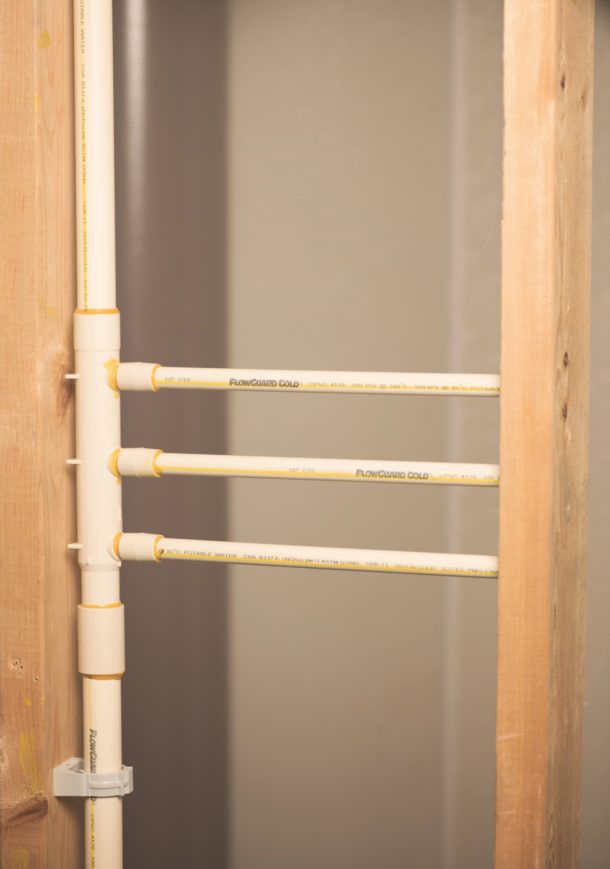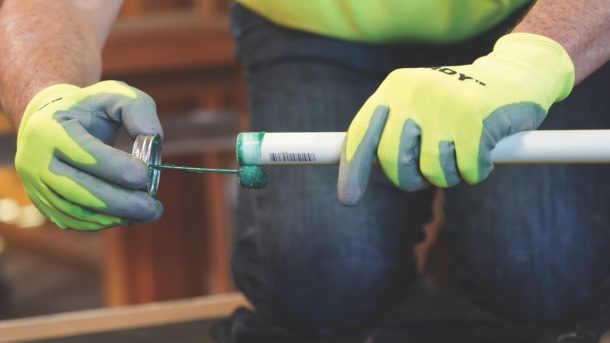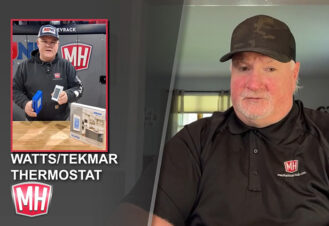There’s a tendency to think that established plumbing systems never change and once you’ve mastered best practices for installation, there isn’t much new to learn.
But before we get to those, let’s review some of those basic practices that can help ensure the success of an installation using CPVC pipes and fittings.
Installing CPVC
Other practices to keep in mind include accounting for expansion and contraction. To ensure proper space for expansion due to temperature changes, plan for about 1 inch per 50 feet of straight length of pipe per 50° F temperature increase. This is primarily a consideration for hot water lines but should be applied to cold water lines when they are installed in unusually hot or cold conditions. In most cases, expansion can be accommodated with normal changes of direction, although for long straight runs, loops or offsets are required. In order to properly account for expansion and contraction, CPVC pipes should be allowed to freely move in the direction of expansion.
For more on installing CPVC, you can access step-by-step, installation instructions or download a quick reference installation guide. Now, let’s get to the new developments that have occurred with CPVC plumbing systems this year.
Support for Mini-Manifold Designs
Mini-manifold systems can simplify plumbing installation in multi-family homes and, when properly designed, improve water and energy efficiency. Until recently, these systems were only available for PEX or copper plumbing, both of which have significant limitations that can offset the benefits of mini-manifold systems.
The new FlowGuard MultiPort CPVC manifold can reduce the pressure drop similarly seen in PEX manifolds by more than half. When using manifolds, it’s important to remember that the efficiency benefits are only realized when branch lines are kept short. There is a tendency, particularly when using flexible PEX piping, to run long branches that neutralize the benefits of the manifold and increase material costs. The FlowGuard MultiPort CPVC manifold encourages smart system design keeping branch lines short, ensuring the potential benefits of this design are fully realized.
The FlowGuard MultiPort CPVC manifold also expands the potential applications of this design by enabling their use in areas where local water conditions are too aggressive or corrosive for PEX or copper piping. In addition to the pressure and temperature conditions that can reduce PEX’s ability to resist chlorine degradation, local water conditions can have a similar effect if the oxidative reduction potential of the water flowing through the pipes is above 825 mV. With more municipalities switching from chlorine to chlorine dioxide and increasing the concentration of both disinfectants in their water supply, this condition is becoming more common.
 With new environmental codes and standards encouraging reduced water volume between the hot water source and fixtures, the FlowGuard MultiPort CPVC manifold system creates the opportunity to minimize the entrained water in the system and maximize points earned under the LEED and NGBS rating systems.
With new environmental codes and standards encouraging reduced water volume between the hot water source and fixtures, the FlowGuard MultiPort CPVC manifold system creates the opportunity to minimize the entrained water in the system and maximize points earned under the LEED and NGBS rating systems.
High-Contrast Solvent Cement Gains 2024 Code Approvals
For the last 30 years, the plumbing code has required one-step CPVC cements to be yellow in color. The yellow color of the cement can make it harder to see the cement against the tan CPVC pipe when performing quality control checks, particularly when the pipes are in poorly lit spaces where the background is similarly colored wood stud or subfloor.
Recognizing that this lack of contrast can make inspection more challenging, the Lubrizol FlowGuard Gold team is working with model code organizations on advancing updates to their codes that allow green one-step solvent cement to be used with CPVC. The changes enabling use of high-contrast cement have been finalized and accepted by ICC, including the IPC, IMC and IRC. They are currently unopposed at IAPMO, in the UPC and UMC.

The only difference between the high-contrast green cement and the standard yellow solvent cement that has historically been used is the color. The new cement follows the same installation instructions and provides the same bonding strength as yellow solvent cement.
Continuing to Evolve
For plumbing systems like FlowGuard Gold CPVC that have proven their reliability in U.S. water systems for decades there isn’t a need for changes in material composition or system design. But there are opportunities to continue to evolve these systems to stay current with plumbing trends and resolve minor issues. To stay current on new FlowGuard Gold CPVC products and best practices, you can sign up to receive updates here.
Article submission by Jonathan Simon
Jonathan Simon is the North American residential plumbing manager for Lubrizol Advanced Materials Inc., the parent company for FlowGuard Gold Pipe and Fittings. For 60 years, FlowGuard Gold Pipe and Fittings has provided reliable hot and cold water plumbing systems to residential and commercial buildings.




Join the conversation: